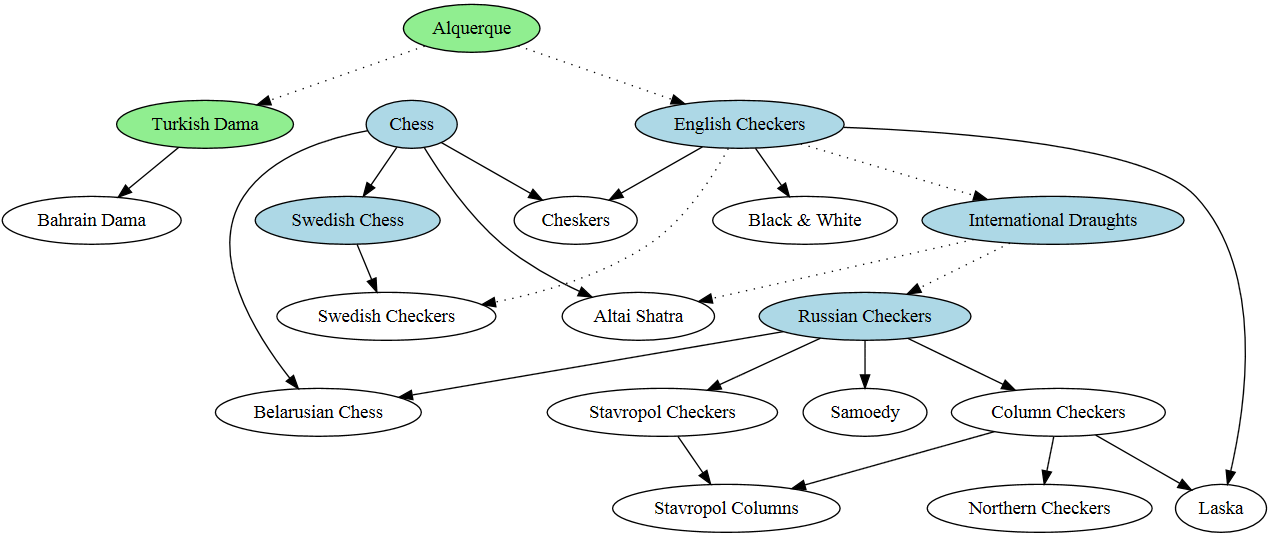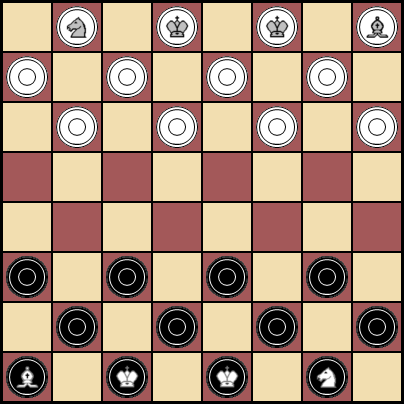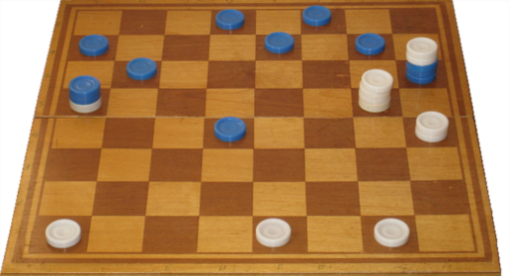Weird Checkers
 Everything is strange and strange!
Everything is strange and strange!
Everything is wonderful and wonderful!
Everything is curious and curious!
Stranger and stranger!
Lewis Carroll "Alice in Wonderland"
Those who think that checkers are some kind of game are mistaken. As a person who has devoted some time to the issue , I can state with full responsibility that the matter is not limited to just one game! And it is not only about Russian , English , Spanish , Italian and even international drafts. All this is just the tip of the iceberg. There are also stranger, much stranger game systems. And I will tell you about them.
For a start, it is worth deciding what makes the checkers checkers. What are the criteria for ownership of the game to this family? Many believe that the main difference between checkers and chess is the game of the same type of figures. Of course, this is a very superficial judgment. In checkers there are ladies. And they are an important part of the game. Only very few varieties of drafts are actually played by figures of the same type. So what is the main thing? In my opinion, two things:
- Completion of the game with no possible moves.
- Obligation to take
First of all, in drafts games there is no special purpose, such as taking the main figure or placing the pieces according to a certain pattern. The goal of the game is as simple as possible - to leave the opponent without the possibility of a turn! No matter how we achieve it - “eating” all the figures or “locking” them. The second feature is the obligatory taking. If there is a possibility of attacking the opponent's figure, we must take it!
From game to game, this principle varies, but it remains perhaps the main rule of most drafts games (I know only one traditional game in which taking is not obligatory). Attempts to abandon this rule have been made , but in modern checkers the game has not taken root (with the exception of some African species). This is not by chance, since the obligatory taking is the basis of the whole matching game. Only it allows you to lure the enemy into a trap and, in combination with composite moves, allows you to "sacrifice less, pick up more."

As usual, you can “poke” in the picture to play something from all this. The color shows the traditional games. As for the games "not traditional", all this, as a rule, is relatively recent inventions. As in the case of fiction, in my opinion, the “principle of one assumption” works fine. The famous game is taken and only one rule changes in it. For example, it is allowed to “eat” your own figures. Taking into account the obligatory capture, the gameplay turns out to be quite not boring:
No less amusing is a game in which it is allowed to “walk” with enemy figures (the mandatory capture remains “in force”, for both sides). Of course, these principles can be combined. So “Stavropol Samoyeds” are born. Sometimes, to determine what is the difference from the traditional game, it is quite difficult. For example, " Bahraini drafts " differ from Turkish very slightly. Of course, much more often the differences are more noticeable.
Two meters of barbed wire
Everyone remembers the result of crossing a hedgehog with a snake? With the two most famous (in any case, on our territory) games, similar experiments were carried out repeatedly. A checker game, with chess pieces added to it, invented by Solomon Golomb in 1948, gave the name to the whole family. Cheskers - "word-wallet", in the best traditions of Lewis Carroll. The Russian-language name , in my opinion, is a little less euphonic, but also keeps traditions.

Strictly speaking, this is not quite checkers. The goal of the game is changed - the winner is the one who first eats all the kings of the opponent, but, unlike chess, the number of kings on the board can be increased! It is in them that the “ordinary” figures on the last line are transformed (since English , rather than Russian drafts, are taken as the basis, kings are quite slow moving). Additional figures "Elephant" and a slightly modified "Horse" also give the game some variety. The main principle is the principle of compulsory taking. It is valid for all shapes!
No less successful is the brainchild of Belarusian comrades. All the rules of chess and checkers (in their Russian variety) are in effect here, and the battle is obligatory only for checkers. Oddly enough, the game is pretty interesting. Due to the fact that the capture of the sword more priority than even protection from the shah, in the game it is quite possible incidents such as checkmate with the king.

Strictly speaking, this is not quite checkers. The goal of the game is changed - the winner is the one who first eats all the kings of the opponent, but, unlike chess, the number of kings on the board can be increased! It is in them that the “ordinary” figures on the last line are transformed (since English , rather than Russian drafts, are taken as the basis, kings are quite slow moving). Additional figures "Elephant" and a slightly modified "Horse" also give the game some variety. The main principle is the principle of compulsory taking. It is valid for all shapes!
No less successful is the brainchild of Belarusian comrades. All the rules of chess and checkers (in their Russian variety) are in effect here, and the battle is obligatory only for checkers. Oddly enough, the game is pretty interesting. Due to the fact that the capture of the sword more priority than even protection from the shah, in the game it is quite possible incidents such as checkmate with the king.
Swedish checkers are a rather curious kind of game for four people. However, they hardly know about her in Sweden. Usually this number is done with chess . The bottom line is that the game is played by a couple and a pair simultaneously on two boards. Taken pieces are transferred “to the reserve” to a partner and can be entered into the game by him on another board. Checkers Swedes are a great example of applying a certain general principle for creating a new game. The game is very young, but it already hosts tournaments.

Pillar checkers - the game, by contrast, more respectable age. As in the Swedes, the pieces in it never leave the game, but they do it in a completely different way! When performing a capture, the enemy figure is taken “captured”, leaving under the base of the “tower” and can be subsequently released (when taken, the one uppermost piece is always removed from the “tower”). To say that this complicates the game is to greatly diminish the scale of how much this game mechanic confuses even the most experienced shashishists!
Towers with several figures of the same color at the top acquire incredible strength, perhaps even greater than the strength of the “flying ladies”. By the way, catching a lonely lady (even on the big horse!) And the “dead death” connected with this in pillar drafts are not such a big problem. This is an extremely well thought out and balanced game, the only disadvantage of which is, perhaps, only its high complexity (both for people and for computers).
The pillars served as an inspiration for other games, such as Laska , developed in 1911 by the great chess grandmaster Emanuel Lasker . However, the Russian person, to play it hard. The ladies in this game are "slow moving", taken from the English drafts . As a result, with equal play of the opponents, the endgames are very long and, as a rule, drawn. To some extent, the development of the idea of stolkovye drafts is " Northern ", as well as a variety of options for " High-rise " drafts.
Why am I all this? A lot of checkers! With the most different degrees of strangeness. This is a lively, dynamic family of board games. It is foolish to “bury” the checkers only for the reason that someone managed to fully calculate on the computer (not even from any possible, but only from the initial position) one of the simplest of their varieties. Play checkers! They are interesting.
All Articles